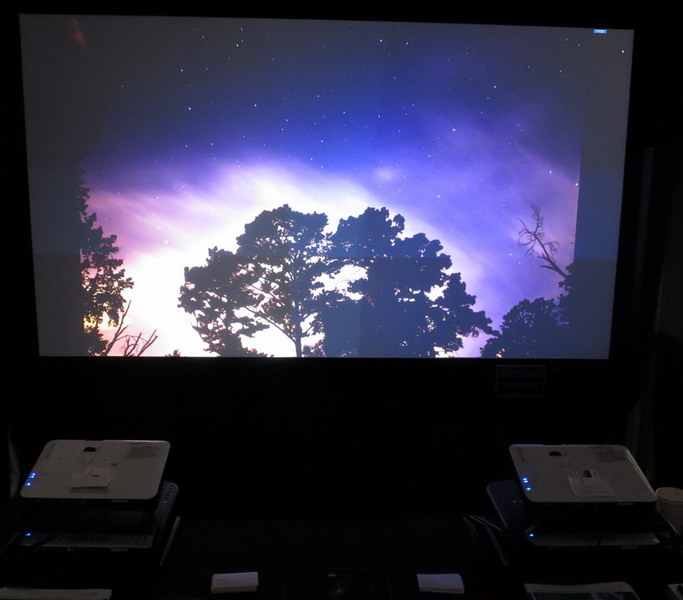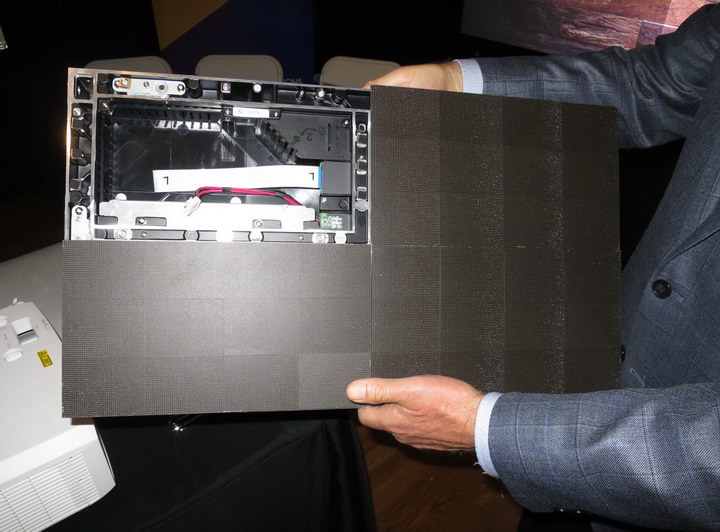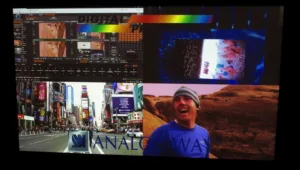Companies exhibiting at Sapphire Marketing’s New York City roadshow event were all looking to tap into the New York professional AV market at the heavily attended event on May 16th. In addition, the companies were looking forward to InfoComm to be held in Las Vegas on June 2 – 6. Several of the companies were willing to share what new products they would be introducing at InfoComm.
Scalable Display Technologies
 Scalable’s blend of 4 projectors at the Sapphire Roadshow. (Credit: M. Brennesholtz)
Scalable’s blend of 4 projectors at the Sapphire Roadshow. (Credit: M. Brennesholtz)
Scalable Display Technologies was showing off its camera-based projector blending technology in the Digital Projection booth. They were blending four low-cost Epson (In the DP booth!) 1080p projectors into a single near-UHD image. The blend wasn’t actually that good and in several of the demonstration still images the blend was clearly visible. The Scalable representative, Sam Pietsch, said that was because of the haste the system had been set up earlier that morning. Surprisingly, the blend was more visible to the eye than it was to the camera with darker images being the worst case and the blend hardly visible in bright images.
Pietsch told me that, at InfoComm, Scalable would be introducing Version 4.5 of their scaling and blending software. He said this has two added features compared to the current version of the software. First, and more importantly, it will do 16 bit blending. Second, it will have a feature called “Spot Checker.” This feature will allow the person doing the set-up to look at individual pixels from each of the projectors in the blend region to check for pixel distortion and other issues associated with the projector, the lens or the curved screen.
Pietsch also told me that on May 20th Brown University will be reopening its virtual reality environment, the YURT (YURT Ultimate Reality Theatre), which had been shut down for several years. He said this immersive CAVE-like theater involves 69 full HD projectors driven by 20 nodes of the Brown Center for Computation and Visualization (CCV) HPC cluster. The projectors display onto 145 mirrors covering a 360º surface including overhead and underfoot. At normal viewing distances, the pixels are smaller than are resolvable by the human retina. The rear-projection screens consists of translucent polycarbonate. The front wall is 25′ long and 8′ (7.6 x 2.4 m) high and spans 180 degrees of view. A Brown University video of the YURT is available here.
Digital Projection
Four 1080P images shown on the DP E-Vision Laser 4K/UHD projector at the Roadshow. The images were merged and the DP and Analog Way logos were added by an Analog Way media server processor. (Credit: M. Brennesholtz)
I talked to Chuck Collins, VP of sales at Digital Projection (DP), about both the projectors they were showing at the Sapphire Roadshow and new projectors to be introduced at InfoComm. The ones being shown at the Roadshow were the E-Vision Laser 4K/UHD with 7500 ISO lumens and 3840 x 2150 resolution and the M-Vision Laser 18000 WUXGA with 18,000 lumens and 1920 x 1200 resolution.
He said that the 8K projector previously shown at InfoComm 2017 and I saw in February, 2018 at ISE will be formally introduced to the US Market. (see the ISE Special Report ) (and at ProLight & Sound – Man. Ed.) At all these demonstrations, DP used Analog Way media servers to produce the needed 16 x DisplayPort inputs to the projector. ISE was the formal introduction to the European market. He said this projector is expected to ship to customers in Q4. He did say that there have already been several installations of a pre-production version of the projector in Asia. Not surprisingly, one installation was at NHK. He declined to identify the others but said they were in the visualization, simulation and planetarium markets, not the cinema-type entertainment market. Other projectors to be demonstrated and introduced at InfoComm 2018 include:
- E-Vision Laser 11000 4K. (11,000 Lumens, UHD resolution 3840 x 2160) The E-Vision Laser 4K projector shown at the roadshow has 7500 lumens.
- E-Vision Laser 13000WU (WUXGA).
- M-Vision Laser 21000WU This will be a brighter version of the M-Vision Laser 18000 WUXGA (1920 x 1200) projector shown at the Roadshow.
- Titan Laser 33000 4K
- Titan Laser 37000WU
- E-Vision Reference 4K. This is expected to be a static unit and not producing an image. It will use both blue and red lasers and is expected to produce Rec. 2020 colorimetry.
 DP Radiance LED Tile with one panel removed. (Credit: M. Brennesholtz)
DP Radiance LED Tile with one panel removed. (Credit: M. Brennesholtz)
Digital Projection was also demonstrating its Radiance LED video wall as a 2 x 2 tile of 1.2mm pitch modules. To make a FHD (1020 x 1080) TV, the wall would need to be a tile of 4 x 4. I was told this was made entirely by Digital Projection, with the explanation that Digital Projection was now a “Delta Associate Company” and the units were actually made by Delta in its factories. Sapphire only represents Radiance LED products in the consumer market and DP described how, for a home theater, they take the entire responsibility from design through installation and maintenance. Sapphire represents Silicon Core in the US Commercial market, so DP did not discuss any commercial applications of its Radiance LED tiles.
Stewart Filmscreen
Stewart Filmscreen was demonstrating its Phantom front projection screen material, introduced last year at InfoComm, in a side-by side comparison with a matte white screen material. Phantom is a rollable, contrast enhancing material that can be made in virtually unlimited size.
Todd Eddy, VP of Global Commercial Sales at Stewart, told me that at InfoComm the company will be introducing a new rear projection screen material. This material has not been named yet but it will be contrast-enhancing and designed for ultra-short throw projectors. He added that the previously introduced Stewart Fidelity Vision material will be re-launched at InfoComm. This material is designed to be an overlay for direct-view LED screens that will reduce the visibility of the individual LED pixels.
Analog Way
 The Hershey’s and NFL Experience 8K display on Times Square was made from SNA tiles and driven by four Analog Way Ascender media servers. (Credit: M. Brennesholtz)
The Hershey’s and NFL Experience 8K display on Times Square was made from SNA tiles and driven by four Analog Way Ascender media servers. (Credit: M. Brennesholtz)
Analog Way was showing two of its Media Servers at the Roadshow, the Picturall and the Ascender. The Picturall is a new design and its formal introduction will be at InfoComm in June. A single Picturall Pro – MSP16-R1 will handle a 10 bit, 8K display by itself with its 16 x DisplayPort 1.2 outputs. The Ascender unit is older but is still being used in new installations. Seth Teates, Regional Sales Manager and CTS-D, told me that four Ascender units in parallel are normally used to drive the DP 8K projector.
Teates also said four Ascenders were used to drive the 8K LED video wall shared by Hershey’s Chocolate and the NFL Experience on Times Square. He said this is the highest resolution video wall currently installed in Times Square and it used LED tiles from Sansi North America (SNA). After leaving the Roadshow, I headed up to Times Square to see the display. It is a curved unit with part of it on 7th Avenue and part on 47th Street. There was no place where I could get a photograph of the entire display. There was also no place where I could see the individual pixels of the display from the street. High resolution and fine pitch has its advantages.
Teates added that he had recently finished installation and commissioned another Ascender/SNA display in New York, in the lobby of the Sales Force office. This unit was less than 8K resolution and when you can see 8K, why bother with less? –Matthew Brennesholtz

